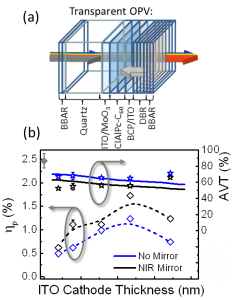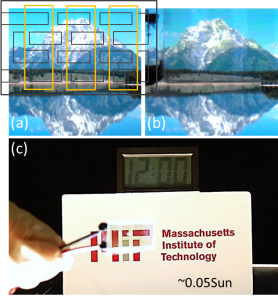Transparent Organic Photovoltaics for Window Applications
- Category: Electronic Devices, Energy, Nanotechnology, Optics & Photonics
- Tags: Richard Lunt, Vladimir Bulovic
The low energy density of solar illumination necessitates deployment of solar technologies over large surface areas in order to capture enough of the sun’s energy to offset a significant portion of non-renewable energy consumption. The obstacle of large-area deployment could be overcome with development of a low-cost, transparent, photovoltaic (PV) technology that can be integrated onto window panes in homes, skyscrapers, and automobiles, enhancing the functionality of already utilized transparent surfaces. Since glass, structural framing, and inverters comprise nearly 40% of thin-film PV module prices [1] , integrating solar cells into windows can also reduce effective installation costs. Presently, window glass used in automobiles and in architectural installations [2] requires 70-80% and 55-90% transmission to visible light, respectively. Previous efforts to construct semitransparent devices have focused on the use of thin active layers (or spatially segmented films) with light absorption focused in the visible spectrum and therefore have been limited to either low efficiencies or low average visible-light transmissivity since both parameters cannot be simultaneously optimized.
We demonstrate an additive transparent organic PV technology (see Figure 1a) that can similarly retain the glass transparency, where the non-transmitted light in the near-infrared is utilized for power generation. To do this, we exploit the excitonic character of organic and molecular semiconductors to produce photovoltaic architectures with structured absorption, i.e., exhibiting minima and maxima that are uniquely distinct from the band-absorption of their inorganic counterparts. Combining these PVs with selective high-reflectivity near-infrared mirrors, we demonstrate a prototype transparent device with a power conversion efficiency of several percent (Figure 1b) while also permitting more than 60% transmission of visible light through the entire device [3] . Finally, we demonstrate that a series-integrated array of these transparent cells is capable of powering electronic devices under near-ambient lighting (see Figure 2), making them highly useful for distributed and point-of-source utilization of solar energy.
- Figure 1: (a) Schematic of the transparent organic photovoltaic architecture. (b) Measured power efficiency (ηp) and average visible transparency (AVT) of the devices as a function of the cathode thickness.
- Figure 2: (a-b) Picture of the “Teton mountains” displayed on an LCD screen with the fully assembled transparent solar cell in front of the picture where the cell design is shown in (a). (c) Picture of the series-integrated transparent OPV powering an LCD clock.
- K. Zweibel, “The terawatt challenge for thin film photovoltaics,” Thin Film Solar Cells, Hoboken, NJ, John Wiley and Sons Ltd., 2006, pp. 427-459. [↩]
- C. Tuchinda, S. Srivannaboon, and H. W. Lim, “Photoprotection by window glass, automobile glass, and sunglasses,” Journal of the American Academy of Dermatology, vol. 54, pp. 845-854, 2006. [↩]
- R. R. Lunt and V. Bulovic, “Transparent, near-infrared organic photovoltaic solar cells for window and energy-scavenging applications,” Applied Physics Letters, vol. 98, pp. 113305:1-3, 2011. [↩]

